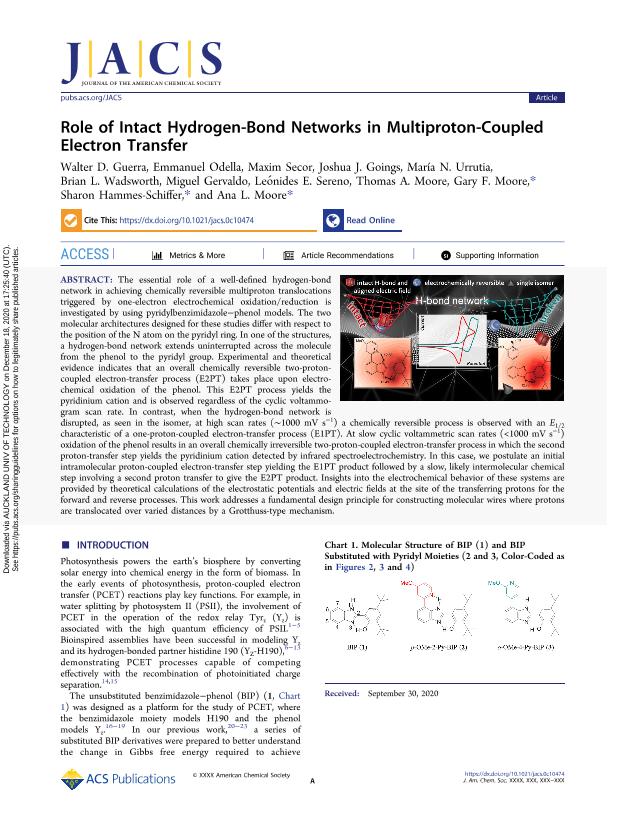Mostrar el registro sencillo del ítem
dc.contributor.author
Guerra, Walter Damián

dc.contributor.author
Odella, Emmanuel

dc.contributor.author
Secor, Maxim
dc.contributor.author
Goings, Joshua J.
dc.contributor.author
Urrutia, María N.
dc.contributor.author
Wadsworth, Brian L.
dc.contributor.author
Gervaldo, Miguel Andres

dc.contributor.author
Sereno, Leonides Edmundo

dc.contributor.author
Moore, Thomas A.
dc.contributor.author
Moore, Gary F.
dc.contributor.author
Hammes-Schiffer, Sharon
dc.contributor.author
Moore, Ana L.
dc.date.available
2021-07-15T20:29:43Z
dc.date.issued
2020-12
dc.identifier.citation
Guerra, Walter Damián; Odella, Emmanuel; Secor, Maxim; Goings, Joshua J.; Urrutia, María N.; et al.; Role of intact hydrogen-bond networks in multiproton-coupled electron transfer; American Chemical Society; Journal of the American Chemical Society; 142; 52; 12-2020; 21842-21851
dc.identifier.issn
0002-7863
dc.identifier.uri
http://hdl.handle.net/11336/136290
dc.description.abstract
The essential role of a well-defined hydrogen-bond network in achieving chemically reversible multiproton translocations triggered by one-electron electrochemical oxidation/reduction is investigated by using pyridylbenzimidazole-phenol models. The two molecular architectures designed for these studies differ with respect to the position of the N atom on the pyridyl ring. In one of the structures, a hydrogen-bond network extends uninterrupted across the molecule from the phenol to the pyridyl group. Experimental and theoretical evidence indicates that an overall chemically reversible two-proton-coupled electron-transfer process (E2PT) takes place upon electrochemical oxidation of the phenol. This E2PT process yields the pyridinium cation and is observed regardless of the cyclic voltammogram scan rate. In contrast, when the hydrogen-bond network is disrupted, as seen in the isomer, at high scan rates (μ1000 mV s-1) a chemically reversible process is observed with an E1/2 characteristic of a one-proton-coupled electron-transfer process (E1PT). At slow cyclic voltammetric scan rates (<1000 mV s-1) oxidation of the phenol results in an overall chemically irreversible two-proton-coupled electron-transfer process in which the second proton-transfer step yields the pyridinium cation detected by infrared spectroelectrochemistry. In this case, we postulate an initial intramolecular proton-coupled electron-transfer step yielding the E1PT product followed by a slow, likely intermolecular chemical step involving a second proton transfer to give the E2PT product. Insights into the electrochemical behavior of these systems are provided by theoretical calculations of the electrostatic potentials and electric fields at the site of the transferring protons for the forward and reverse processes. This work addresses a fundamental design principle for constructing molecular wires where protons are translocated over varied distances by a Grotthuss-type mechanism.
dc.format
application/pdf
dc.language.iso
eng
dc.publisher
American Chemical Society

dc.rights
info:eu-repo/semantics/openAccess
dc.rights.uri
https://creativecommons.org/licenses/by-nc-sa/2.5/ar/
dc.subject
Proton-coupled electron transfer
dc.subject
Benzimidazole−phenol
dc.subject
Cyclic voltammetry
dc.subject
Bioinspired assemblies
dc.subject.classification
Química Orgánica

dc.subject.classification
Ciencias Químicas

dc.subject.classification
CIENCIAS NATURALES Y EXACTAS

dc.title
Role of intact hydrogen-bond networks in multiproton-coupled electron transfer
dc.type
info:eu-repo/semantics/article
dc.type
info:ar-repo/semantics/artículo
dc.type
info:eu-repo/semantics/publishedVersion
dc.date.updated
2021-04-23T16:38:46Z
dc.identifier.eissn
1520-5126
dc.journal.volume
142
dc.journal.number
52
dc.journal.pagination
21842-21851
dc.journal.pais
Estados Unidos

dc.description.fil
Fil: Guerra, Walter Damián. Consejo Nacional de Investigaciones Científicas y Técnicas. Centro Científico Tecnológico Conicet - Córdoba. Instituto de Investigaciones en Físico-química de Córdoba. Universidad Nacional de Córdoba. Facultad de Ciencias Químicas. Instituto de Investigaciones en Físico-química de Córdoba; Argentina. Arizona State University; Estados Unidos
dc.description.fil
Fil: Odella, Emmanuel. Arizona State University; Estados Unidos. Universidad Nacional de Río Cuarto. Facultad de Ciencias Exactas Fisicoquímicas y Naturales. Departamento de Química; Argentina. Consejo Nacional de Investigaciones Científicas y Técnicas; Argentina
dc.description.fil
Fil: Secor, Maxim. University of Yale; Estados Unidos
dc.description.fil
Fil: Goings, Joshua J.. University of Yale; Estados Unidos
dc.description.fil
Fil: Urrutia, María N.. Arizona State University; Estados Unidos
dc.description.fil
Fil: Wadsworth, Brian L.. Arizona State University; Estados Unidos
dc.description.fil
Fil: Gervaldo, Miguel Andres. Universidad Nacional de Río Cuarto. Facultad de Ciencias Exactas Fisicoquímicas y Naturales. Instituto de Investigaciones en Tecnologías Energéticas y Materiales Avanzados. - Consejo Nacional de Investigaciones Científicas y Técnicas. Centro Científico Tecnológico Conicet - Córdoba. Instituto de Investigaciones en Tecnologías Energéticas y Materiales Avanzados; Argentina
dc.description.fil
Fil: Sereno, Leonides Edmundo. Universidad Nacional de Río Cuarto. Facultad de Ciencias Exactas Fisicoquímicas y Naturales. Departamento de Química; Argentina
dc.description.fil
Fil: Moore, Thomas A.. Arizona State University; Estados Unidos
dc.description.fil
Fil: Moore, Gary F.. Arizona State University; Estados Unidos
dc.description.fil
Fil: Hammes-Schiffer, Sharon. University of Yale; Estados Unidos
dc.description.fil
Fil: Moore, Ana L.. University of Yale; Estados Unidos
dc.journal.title
Journal of the American Chemical Society

dc.relation.alternativeid
info:eu-repo/semantics/altIdentifier/url/https://pubs.acs.org/doi/10.1021/jacs.0c10474
dc.relation.alternativeid
info:eu-repo/semantics/altIdentifier/doi/http://dx.doi.org/10.1021/jacs.0c10474
Archivos asociados
